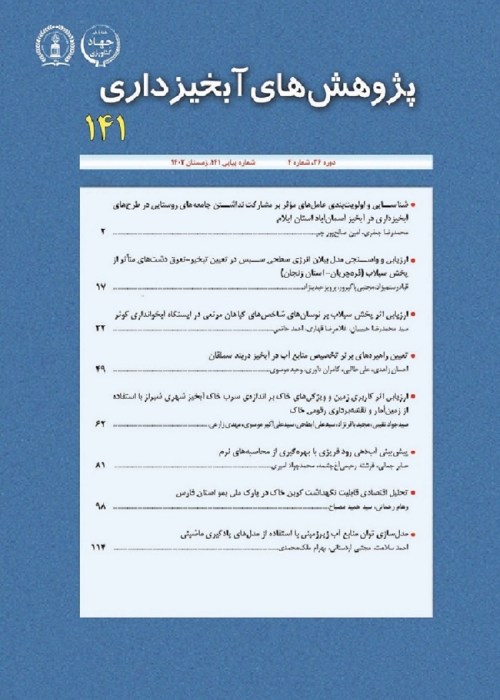Study of Phenological stages and Plant Dimensions and Effect of Drought on two grass species in the steppe rangelands (Case study: Rangelands of Nodoushan in Yazd Province)
Author(s):
Abstract:
Ranges are composed of different species, each of them having its own phonology and dimensions. Knowledge of these species characteristics are important in rangeland management. The aim of the study was to determine the Phenological stages and resize of two species of Stipa barbata Dest and Stipa caucasica Schmalh in Nodoushan steppe rangelands of Yazd during the period of 4 years (2007-2010). First, for each species, 10 individuals per plant species were identified within the enclosure and in the study process of this plants were inventoried. Any information phenological stages and dimensions at intervals of 15 days and 7 days, respectively, were measured at vegetative and reproductive stages. Based on these results, the growth of Stipa barbata starts from the Third decade of January. Flowering occurs during the Third decade of April to First decade of May. seed ripening stage of this species in the study area occurs during the Third decade of May to second decade of Jun. Maximum canopy height was 91 cm, which is owned by the Relatively dry year, 2010, and at least it was 23 cm, which is related to the very dry year, 2008,and this difference is significant. Maximum and minimum canopy diameter were respectively 43 cm (in Common year, 2009) and 32 cm (in very dry year, 2008) and the differences are significant (P≤0.05). Canopy diameter in a relatively dry year (2010), Common (2009) and wet year (2007) was not significantly different (P≤0.05). growth of Stipa caucasica starts from the third decade of January. Flowering plants occur in the second decade April to the first decade of May This seed ripening stage is the third decade of May to first decade of Jun. Maximum canopy height was 38 cm, which is owned by the Relatively dry year, 2010, and at least it was 12 cm, which is related to the very dry year, 2008, and this difference is significant. Canopy diameter in a relatively dry year (2010), Common (2009) and wet year (2007) was not significantly different (P≤0.05). Maximum and minimum canopy diameter were respectively 34 cm (Relatively dry year, 2010) and 27 cm (in very dry year, 2008) and the differences are significant (P≤0.05).
Keywords:
Language:
Persian
Published:
Whatershed Management Research, Volume:27 Issue: 103, 2014
Pages:
43 to 51
magiran.com/p1541593
دانلود و مطالعه متن این مقاله با یکی از روشهای زیر امکان پذیر است:
اشتراک شخصی
با عضویت و پرداخت آنلاین حق اشتراک یکساله به مبلغ 1,390,000ريال میتوانید 70 عنوان مطلب دانلود کنید!
اشتراک سازمانی
به کتابخانه دانشگاه یا محل کار خود پیشنهاد کنید تا اشتراک سازمانی این پایگاه را برای دسترسی نامحدود همه کاربران به متن مطالب تهیه نمایند!
توجه!
- حق عضویت دریافتی صرف حمایت از نشریات عضو و نگهداری، تکمیل و توسعه مگیران میشود.
- پرداخت حق اشتراک و دانلود مقالات اجازه بازنشر آن در سایر رسانههای چاپی و دیجیتال را به کاربر نمیدهد.
In order to view content subscription is required
Personal subscription
Subscribe magiran.com for 70 € euros via PayPal and download 70 articles during a year.
Organization subscription
Please contact us to subscribe your university or library for unlimited access!


